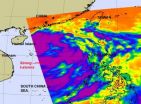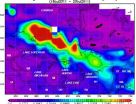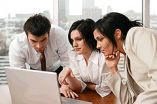(Press-News.org) The human brain is the most complex of all organs, containing billions of neurons with their corresponding projections, all woven together in a highly complex, three-dimensional web. To date, mapping this vast network posed a practically insurmountable challenge to scientists. Now, however, a research team from the Heidelberg-based Max Planck Institute for Medical Research has developed a method for tackling the mammoth task. Using two new computer programs, KNOSSOS and RESCOP, a group of over 70 students mapped a network of more than 100 neurons – and they did so faster and more accurately than with previous methods.
With some 70 billion neurons and hundreds of thousands of kilometres of circuits, the human brain is so complex that, for many years, it seemed impossible to reconstruct the network in detail. Each neuron is linked to about a thousand others by means of finely branched projections called dendrites and axons, and communicates with them using electrical signals. The connections between the cells are critical for brain function, so neuroscientists are keen to understand the structure of these circuits – the connectome – and to reconstruct it in a three-dimensional map. Since no computer is powerful enough yet for the task, researchers are dependent on the human eye. However, the sheer number of cellular connections contained in even the tiniest fragment of tissue makes the undertaking seem pointless – unless it is shared among a large number of people.
Moritz Helmstaedter, Kevin L. Briggman and Winfried Denk, scientists at the Max Planck Institute for Medical Research in Heidelberg, have now successfully tested this procedure. They developed a special software tool called RESCOP which summarises the results of several annotators to yield an overall picture. In this way, and with the support of over 70 students from Heidelberg University, they reconstructed a network of over 100 neurons from the retina in full detail.
The students used the KNOSSOS software developed by the team in Heidelberg to trace the connections between the neurons. It is no coincidence that the program is named after Crete's legendary palace, renowned for its elaborate labyrinth: "Tracing the connections in the brain is at least as hard as finding your way out of a mythological labyrinth", explains Moritz Helmstaedter.
In order to reconstruct a neural circuit, researchers start by staining the neurons of a section of tissue with heavy metals to make them visible. Using three-dimensional electron microscope images, they start at the cell body and follow the dendrites and axons, marking the branch point nodes on the screen. Then they use the computer to generate a three-dimensional image of the section. In this way, they work their way through the tangle of neurons bit by bit. It is a tedious undertaking: One person working alone with the currently available programs would take at least 30 years to reconstruct a path of 30 centimetres in length. Besides, these procedures are prone to error, since the branch points are not always easily recognised and the annotator's attentiveness decreases with time.
The KNOSSOS software considerably reduces the time required: It is about 50 times faster than other programs used up to now. In addition, the RESCOP program now makes it possible for dozens of people to work on the reconstruction at the same time. Since the method is easily learned, even non-experts can use it. Most of the students worked from home and sent their results to the scientists via e-mail. The scientists were able to establish that the error rate of the best students was no higher than that of experienced neurobiologists. Moreover, its sophisticated algorithms enable RESCOP to detect and average out inaccuracies. This means that the reconstruction is not only faster, but also more reliable than before.
"For the first time ever, these new programs could make it possible for us to unravel the complicated neural network of the brain – a task far more complex than decoding the human genome", says Winfried Denk. Next, the scientists plan to reconstruct a fragment of the mouse cerebral cortex, as this is where all the important mental processes occur.
INFORMATION:
Moritz Helmstaedter, Kevin L. Briggman, Winfried Denk:
High-accuracy neurite reconstruction for high-throughput neuroanatomy
Nature Neuroscience, Online publication 10 July 2011, doi:10.1038/nn.2868
The brain's connectome -- from branch to branch
Max Planck scientists develop new analytical tools for the fast and accurate reconstruction of neural networks
2011-08-01
ELSE PRESS RELEASES FROM THIS DATE:
DERMagic Awarded 1st Place for Grooming Products in Pet Product News International 2011 'Retailers' Top Pick'
2011-08-01
DERMagic Skin Care for Animals (www.DERMagic.com) today announced its popular and recently introduced Organic Skin Rescue Shampoo Bar has won 1st Place in the Pet Product News International "2011 Retailer's Top Pick" Awards in the Grooming Products category. Created by the editors at Pet Product News International to identify new products retailers would most like to see on their store shelves, the 2011 Retailers' Top Picks Awards presented product in 14 categories and asked pet specialty retailers to vote for their favorite three within each category.
"We ...
Humabs discovers the first antibody to neutralize both group 1 and group 2 influenza A viruses
2011-08-01
BELLINZONA (Switzerland) – July 28, 2011 – A paper published today in the scientific research journal Science, describes a novel, proprietary monoclonal antibody (FI6) discovered in a collaboration between Humabs BioMed SA, the Institute for Research in Biomedicine ("IRB") and the UK Medical Research Council (MRC). FI6 is the first neutralizing antibody that targets all 16 hemagglutinin subtypes of influenza A and represents an important development in the treatment of severe cases of flu, and in finding a universal flu vaccine. The paper also discusses Humabs' high throughput ...
Oral interferon may prevent and control avian influenza virus infection
2011-08-01
New Rochelle, NY, July 28, 2011—Avian influenza virus is a threat to the commercial chicken industry and, with its recent rapid spread across China, has also shown the ability for transmission from chickens to humans and other mammals. In an article in Journal of Interferon & Cytokine Research, a peer-reviewed journal published by Mary Ann Liebert, Inc., Chinese researchers report that oral chicken interferon-alpha may significantly reduce influenza virus levels when given either preventively or therapeutically. The article is available free online at www.liebertpub.com/jir
Chickens ...
Endorsements matter but voters are wise to media bias
2011-08-01
PROVIDENCE, R.I. [Brown University] — Newspaper endorsements for presidential candidates can influence voting decisions, according to newly published research co-authored by Brown University economist Brian Knight. The paper, co-authored by Chun Fang Chiang, demonstrates that voters are more likely to support the recommended candidate following a newspaper's endorsement, but any degree of influence depends on the credibility of the paper's pick. The findings are published in The Review of Economic Studies.
The researchers take into account that newspapers are potentially ...
Elusive prey
2011-08-01
WORCESTER, Mass. – Escape responses are some of the most studied behaviors by neurobiologists who want to understand how the brain processes sensory information. The ability to evade predators plays a vital role in the process of natural selection. Animals explore their environment to find food, find mates and locate new habitats, and have developed distinct escape responses to avoid predators, thereby increasing their chances for survival. Yet there are few examples that illustrate a complete understanding of the basic biological mechanisms of behavior with its ecological ...
Geographic analysis offers new insight into coral disease spread
2011-08-01
GAINESVILLE, Fla. — In the last 30 years, more than 90 percent of the reef-building coral responsible for maintaining major marine habitats and providing a natural barrier against hurricanes in the Caribbean has disappeared because of a disease of unknown origin.
Now a University of Florida geographer and his colleagues applied Geographic Information Systems, known as GIS — as well as software previously used to examine human illness — to show where clusters of diseased coral exist. Their findings, published this month in the journal PLoS One, may help scientists derive ...
NASA identifies the areas of Tropical Storm Muifa's strength
2011-08-01
The strongest thunderstorms that make up tropical storm Muifa are on the storm's eastern and southern sides, according to infrared imagery from NASA's Aqua satellite. The northern side is being weakened by a nearby weather system.
Tropical Storm Muifa is moving through the western North Pacific Ocean, and had strengthened during the early morning hours of July 28. On July 27, it was tropical depression 11W and winds have since increased to 40 knots (46 mph/74 kmh).
When NASA's Aqua satellite passed over Tropical Storm Muifa the Atmospheric Infrared Sounder (AIRS) instrument ...
NASA eyes Tropical Storm Nock-Ten's heavy rains for Hainan Island and Vietnam
2011-08-01
Infrared satellite imagery from NASA's Aqua satellite shows bands of strong thunderstorms wrapping around the center of Tropical Storm Nock-Ten as it makes its way through the South China Sea and two landfalls on Hainan Island and in Vietnam.
Bands of strong thunderstorms that make up tropical storm Nock-ten were visible in an infrared image captured on July 28 by the Atmospheric Infrared Sounder (AIRS) instrument that flies on NASA's Aqua satellite. The colder the cloud tops, the higher the thunderstorms and the stronger they are, and cloud top temperatures over a large ...
NASA measures wildfire pollution pour over Niagara Falls
2011-08-01
Water isn't the only thing pouring over Niagara Falls. Pollution from fires in Ontario, Canada is also making the one thousand mile trip, while being measured by NASA's Aqua satellite.
One instrument that flies aboard two of NASA's satellites has provided two views of the pollution from the fires in Ontario. The Moderate Resolution Imaging Spectroradiometer, or MODIS instrument, flies onboard NASA's Aqua and Terra satellites. MODIS has provided a visible look at the smoke and pollution that has spread over Niagara Falls and east to Nova Scotia.
As of July 20, the Canadian ...
Cash Advances US Provides Fast Cash Loans Online With No Credit Check
2011-08-01
Less-than-perfect credit score can wipe off any opportunity to get some cash you need at the moment as most of the lenders consider people with bad credit history as high-risk borrowers. However, Cash Advances US offers particular cash loans with no credit check which are available online. The service was actually designed specially for consumers with damaged credit report who often face troubles applying for some extra money.
It's fast and simple to take out online payday advance loans performed by the company as the application process is held totally on the Internet. ...
LAST 30 PRESS RELEASES:
Decoupling the HOR enhancement on PtRu: Dynamically matching interfacial water to reaction coordinates
Sulfur isn’t poisonous when it synergistically acts with phosphine in olefins hydroformylation
URI researchers uncover molecular mechanisms behind speciation in corals
Chitin based carbon aerogel offers a cleaner way to store thermal energy
Tracing hidden sources of nitrate pollution in rapidly changing rural urban landscapes
Viruses on plastic pollution may quietly accelerate the spread of antibiotic resistance
Three UH Rainbow Babies & Children’s faculty elected to prestigious American Pediatric Society
Tunnel resilience models unveiled to aid post-earthquake recovery
Satellite communication systems: the future of 5G/6G connectivity
Space computing power networks: a new frontier for satellite technologies
Experiments advance potential of protein that makes hydrogen sulfide as a therapeutic target for Alzheimer’s disease
Examining private equity’s role in fertility care
Current Molecular Pharmacology achieves a landmark: real-time CiteScore advances to 7.2
Skeletal muscle epigenetic clocks developed using postmortem tissue from an Asian population
Estimating unemployment rates with social media data
Climate policies can backfire by eroding “green” values, study finds
Too much screen time too soon? A*STAR study links infant screen exposure to brain changes and teen anxiety
Global psychiatry mourns Professor Dan Stein, visionary who transformed mental health science across Africa and beyond
KIST develops eco-friendly palladium recovery technology to safeguard resource security
Statins significantly reduce mortality risk for adults with diabetes, regardless of cardiovascular risk
Brain immune cells may drive more damage in females than males with Alzheimer’s
Evidence-based recommendations empower clinicians to manage epilepsy in pregnancy
Fungus turns bark beetles’ defenses against them
There are new antivirals being tested for herpesviruses. Scientists now know how they work
CDI scientist, colleagues author review of global burden of fungus Candida auris
How does stroke influence speech comprehension?
B cells transiently unlock their plasticity, risking lymphoma development
Advanced AI dodel predicts spoken language outcomes in deaf children after cochlear implants
Multimodal imaging-based cerebral blood flow prediction model development in simulated microgravity
Accelerated streaming subgraph matching framework is faster, more robust, and scalable
[Press-News.org] The brain's connectome -- from branch to branchMax Planck scientists develop new analytical tools for the fast and accurate reconstruction of neural networks





